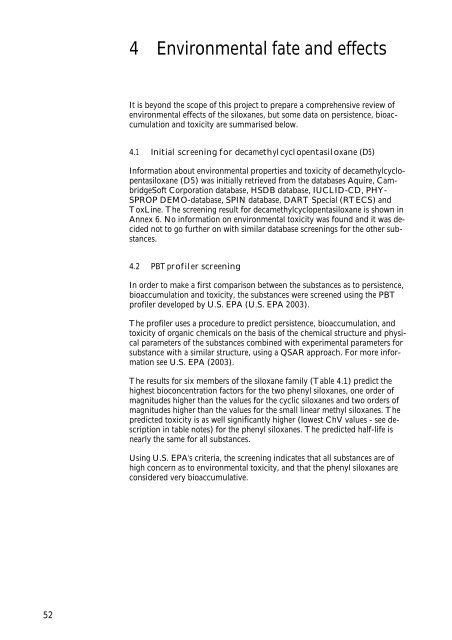No. 1031 - Miljøstyrelsen
No. 1031 - Miljøstyrelsen
No. 1031 - Miljøstyrelsen
You also want an ePaper? Increase the reach of your titles
YUMPU automatically turns print PDFs into web optimized ePapers that Google loves.
52<br />
4 Environmental fate and effects<br />
It is beyond the scope of this project to prepare a comprehensive review of<br />
environmental effects of the siloxanes, but some data on persistence, bioaccumulation<br />
and toxicity are summarised below.<br />
4.1 Initial screening for decamethylcyclopentasiloxane (D5)<br />
Information about environmental properties and toxicity of decamethylcyclopentasiloxane<br />
(D5) was initially retrieved from the databases Aquire, CambridgeSoft<br />
Corporation database, HSDB database, IUCLID-CD, PHY-<br />
SPROP DEMO-database, SPIN database, DART Special (RTECS) and<br />
ToxLine. The screening result for decamethylcyclopentasiloxane is shown in<br />
Annex 6. <strong>No</strong> information on environmental toxicity was found and it was decided<br />
not to go further on with similar database screenings for the other substances.<br />
4.2 PBT profiler screening<br />
In order to make a first comparison between the substances as to persistence,<br />
bioaccumulation and toxicity, the substances were screened using the PBT<br />
profiler developed by U.S. EPA (U.S. EPA 2003).<br />
The profiler uses a procedure to predict persistence, bioaccumulation, and<br />
toxicity of organic chemicals on the basis of the chemical structure and physical<br />
parameters of the substances combined with experimental parameters for<br />
substance with a similar structure, using a QSAR approach. For more information<br />
see U.S. EPA (2003).<br />
The results for six members of the siloxane family (Table 4.1) predict the<br />
highest bioconcentration factors for the two phenyl siloxanes, one order of<br />
magnitudes higher than the values for the cyclic siloxanes and two orders of<br />
magnitudes higher than the values for the small linear methyl siloxanes. The<br />
predicted toxicity is as well significantly higher (lowest ChV values - see description<br />
in table notes) for the phenyl siloxanes. The predicted half-life is<br />
nearly the same for all substances.<br />
Using U.S. EPA's criteria, the screening indicates that all substances are of<br />
high concern as to environmental toxicity, and that the phenyl siloxanes are<br />
considered very bioaccumulative.

















